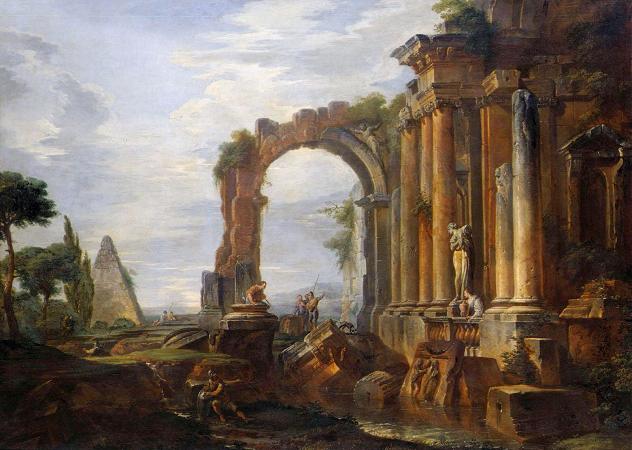Pyramid of Cestius (c-15). The Pyramid of Cestius is an ancient pyramid in Rome, Italy, near the Porta San Paolo and the Protestant Cemetery. It was built as a tomb for Gaius Cestius, a member of the Epulones religious corporation. It stands at a fork between two ancient roads, the Via Ostiensis and another road that ran west to the Tiber along the approximate line of the modern Via Marmorata. Due to its incorporation into the city's fortifications, it is today one of the best-preserved ancient buildings in Rome. The pyramid was built about 18-12 BC as a tomb for Gaius Cestius, a magistrate and member of one of the four great religious corporations in Rome, the Septemviri Epulonum. It is of brick-faced concrete covered with slabs of white marble standing on a travertine foundation. The pyramid measures 100 Roman feet square at the base and stands 125 Roman feet high. In the interior is the burial chamber, a simple barrel-vaulted rectangular cavity measuring 5.95 metres long, 4.10 m wide and 4.80 m high. When opened in 1660, the chamber was found to be decorated with frescoes, which were recorded by Pietro Santo Bartoli. Only scant traces of these frescoes survive, and no trace of any other contents. The tomb had been sealed when it was built, with no exterior entrance, but had been plundered at some time thereafter, probably during antiquity. Until the end of restoration works in 2015, it was not possible for visitors to access the interior, except by special permission typically only granted to scholars. Since the beginning of May 2015, the pyramid is open to the public every second and fourth Saturday each month. Visitors must arrange their visit in advance. A dedicatory inscription is carved into the east and west flanks of the pyramid, so as to be visible from both sides. It reads: Gaius Cestius, son of Lucius, of the gens Pobilia, member of the College of Epulones, praetor, tribune of the plebs, septemvir of the Epulones Below the inscription on the east-facing side is a second inscription recording the circumstances of the tomb's construction. This reads: The work was completed, in accordance with the will, in 330 days, by the decision of the heir Pontus Mela, son of Publius of the Claudia, and Pothus, freedman Another inscription on the east face is of modern origins, having been carved on the orders of Pope Alexander VII in 1663. Reading, it commemorates excavation and restoration work carried out in and around the tomb between 1660-62. At the time of its construction, the Pyramid of Cestius would have stood in open countryside. Rome grew enormously during the imperial period, and, by the 3rd century AD, the pyramid would have been surrounded by buildings. It originally stood in a low-walled enclosure, flanked by statues, columns and other tombs. Two marble bases were found next to the pyramid during excavations in the 1660s, complete with fragments of the bronze statues that originally had stood on their tops. The bases carried an inscription recorded by Bartoli in an engraving of 1697: This identifies Cestius' heirs as Marcus Valerius Messala Corvinus, a famous general; Publius Rutilius Lupus, an orator whose father of the same name had been consul in 90 BC; and Lucius Junius Silanus, a member of the distinguished gens Junia. The heirs had set up the statues and bases using money raised from the sale of valuable cloths. Cestius had stated in his will that the cloths were to be deposited in the tomb, but this practice had been forbidden by a recent edict passed by the aediles. The pyramid was built for Gaius Cestius Epulo, the son of Lucius, of the tribe of Pobilia. The inscription on it mentions that Cestius was a praetor, a tribune of the plebs, and a septemvir of the Epulones. The tomb was completed in 330 days and was one of two pyramid shaped tombs in the city of Rome. The sharply pointed shape of the pyramid is strongly reminiscent of the pyramids of Nubia, in particular of the kingdom of Meroe, which had been attacked by Rome in 23 BC. The similarity suggests that Cestius had possibly served in that campaign and perhaps intended the pyramid to serve as a commemoration. His pyramid was not the only one in Rome; a larger one, the pyramid of Romulus, of similar form but unknown origins stood between the Vatican and the Mausoleum of Hadrian but was dismantled in the 16th century by Pope Alexander VI and the marble was used for the steps of St. Peter's Basilica.
more...













